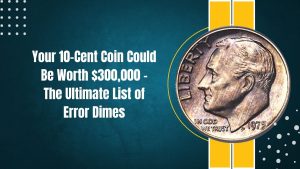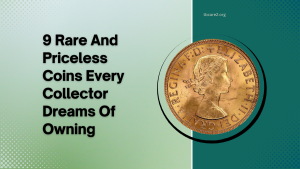Imagine discovering that a seemingly ordinary coin in your pocket is worth a small fortune. In the world of numismatics, certain rare U.S. coins have transformed everyday pocket change into treasures valued at $50,000 or more. This article delves into three such coins, exploring their unique features, historical significance, and the reasons behind their substantial value.
Contents
1. 1969-S Lincoln Cent Doubled Die Obverse
The 1969-S Lincoln Cent is renowned for its prominent doubled die error on the obverse, where the inscriptions and date appear doubled. This error is characterized by noticeable doubling on the inscriptions and date on the coin’s front side.
Due to the precision required in proof coin production, such errors are exceedingly rare. Collectors highly prize these coins, and they have been known to command prices exceeding $50,000, especially in pristine condition.
2. 1970-S Proof Washington Quarter Doubled Die Obverse
The 1970-S Proof Washington Quarter is another coin that has captured the attention of collectors due to its doubled die obverse error. In this variety, the doubling is evident on the inscriptions and the date, making it a distinctive and sought-after piece. The rarity and uniqueness of this error have led to auction prices surpassing $50,000, particularly for specimens in exceptional condition.
3. 1975 No S Proof Roosevelt Dime
The 1975 No S Proof Roosevelt Dime is one of the most elusive coins for collectors. This coin was struck without the San Francisco Mint’s “S” mint mark, a significant error considering all proof coins from that year should bear the mark. Only two such specimens are known to exist, making it extraordinarily rare. In recent auctions, this coin has fetched prices well over $500,000, reflecting its scarcity and desirability among collectors.
Key Details of High-Value 1960s and 1970s Coins
| Coin | Year | Notable Feature | Estimated Value (USD) | Rarity Level |
|---|---|---|---|---|
| 1969-S Lincoln Cent | 1969 | Doubled Die Obverse | $50,000+ | Very High |
| 1970-S Proof Washington Quarter | 1970 | Doubled Die Obverse | $50,000+ | Very High |
| 1975 No S Proof Roosevelt Dime | 1975 | Missing “S” Mint Mark | $500,000+ | Extremely High |
Understanding Coin Rarity and Value
Several factors contribute to a coin’s rarity and value:
- Mintage Numbers: Coins with low production numbers are generally rarer.
- Minting Errors: Errors such as doubled dies or missing mint marks can significantly increase a coin’s value.
- Condition: Coins in mint or uncirculated condition are more valuable than those showing wear.
- Historical Significance: Coins from notable periods or with unique backstories attract higher interest.
Tips for Aspiring Collectors
- Educate Yourself: Learn about different coins, minting processes, and common errors.
- Examine Your Change: Regularly check your pocket change for unusual coins.
- Consult Experts: Seek evaluations from reputable coin dealers or numismatists.
- Preserve Condition: Handle coins carefully to maintain their condition and value.
Discovering a rare coin can be both thrilling and financially rewarding. The 1969-S Lincoln Cent, 1970-S Proof Washington Quarter, and 1975 No S Proof Roosevelt Dime exemplify how numismatic treasures can emerge from everyday pocket change. By staying informed and observant, you might just find a hidden fortune in your own pocket.
FAQs
What is a doubled die error?
A doubled die error occurs during the minting process when the coin’s design is stamped more than once in misaligned positions, resulting in doubled images.
How can I identify a 1969-S Lincoln Cent with a doubled die obverse?
Look for noticeable doubling on the date and inscriptions on the coin’s obverse (front) side.
Why is the 1975 No S Proof Roosevelt Dime so valuable?
Its value stems from its extreme rarity; only two specimens are known to exist without the “S” mint mark.
Where can I get my coins appraised?
Consult reputable coin dealers, numismatists, or professional grading services for accurate appraisals.
How should I store valuable coins?
Store them in a cool, dry place using protective holders to prevent damage and preserve their condition.







I HAVE A 1975 NO-MINT DIME NEVER BEEN RATED BUT I HAVE IT SEALED IN A COIN CAPSULE. WHAT IS MY NEXT STEP?